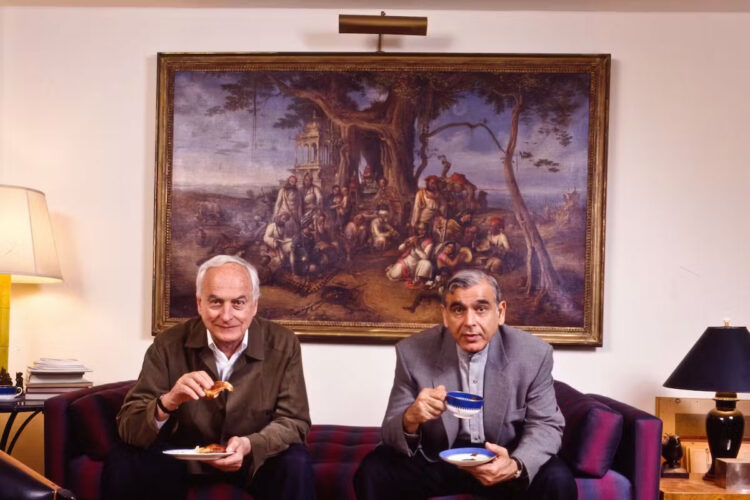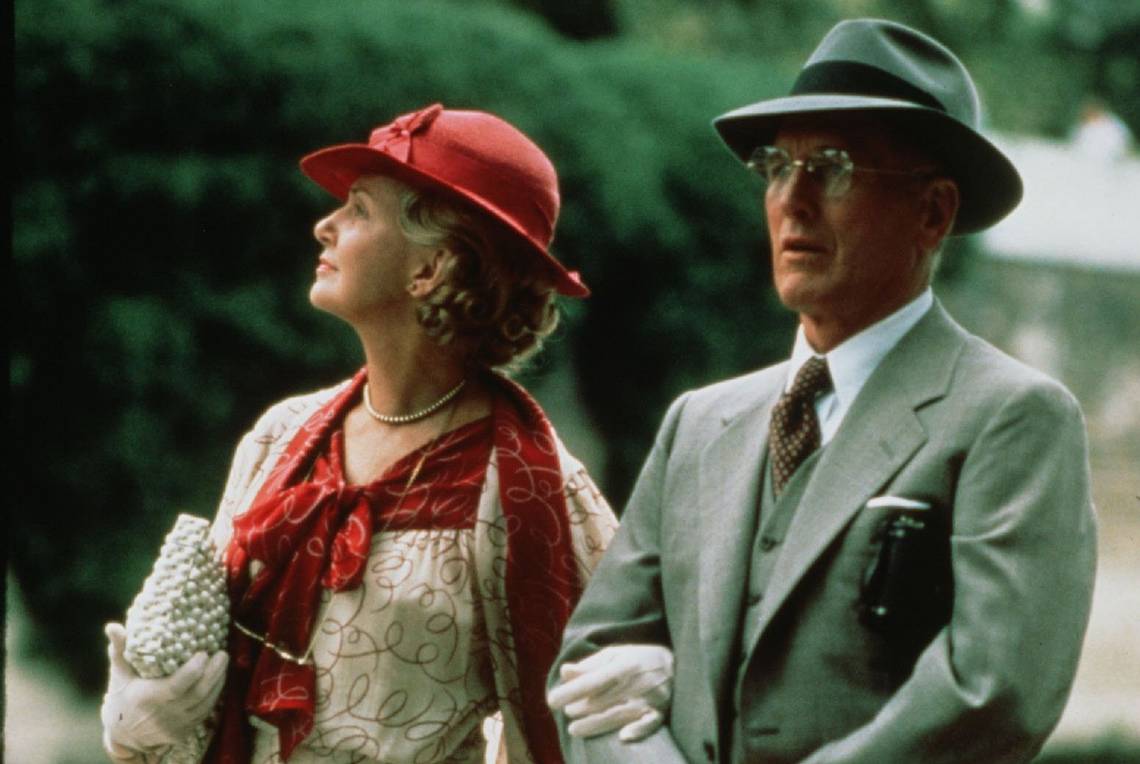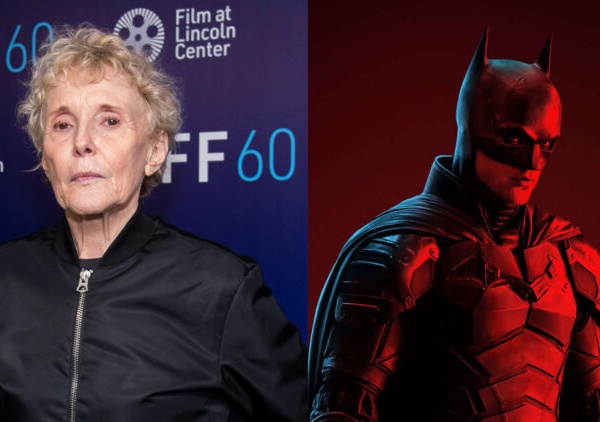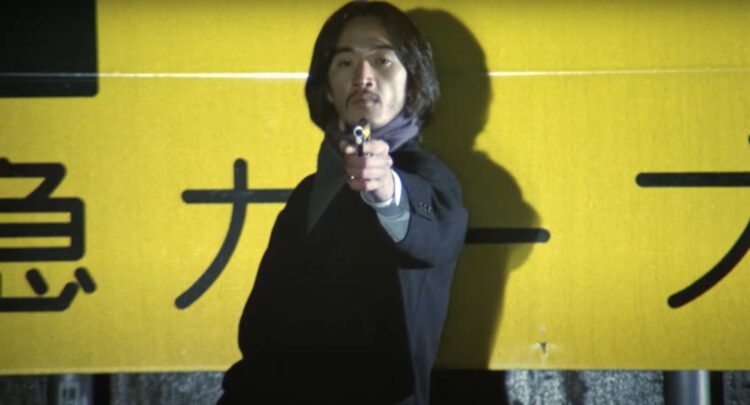

James Ivory has made so many films. And of the forty-plus he’s made––nearly everything under the Merchant Ivory Productions banner––many are masterpieces. Truly, you could count on one hand the number of living filmmakers as accomplished as James Ivory. So what an honor, then, to speak with him and filmmaker Stephen Soucy about the new documentary Merchant Ivory (directed by Soucy) and the many films of Merchant Ivory. There’s talk of those famous Ismail Merchant crew meals, the film Ivory thinks is their best, the one unrealized project that Ivory wishes they had made, and giving performance notes to Paul Newman on the set of Mr. and Mrs. Bridge.
The Film Stage: Stephen, with the documentary, it’s fascinating to rewatch it and think about the breadth of work as a documentarian. What is the “in,” initially, for you? What is the movie or the question that starts it and gets you going?
Stephen Soucy: I think I’d start by saying, I made a short animated film called Rich Atmosphere: The Music of Merchant Ivory Films. I interviewed twice for that, what I thought was going to be a short documentary film and I found the footage just kind of boring. It was Jim talking about his working relationship with [composer] Dick Robbins and the music for me was always one of the things that really stuck with me after I saw every Merchant Ivory film. Because, again, I got to know Merchant Ivory first with A Room with a View, and then Maurice, and then I followed them from that point on, and then I went back and looked at some of the older films. You know, eventually I’d say ––
James Ivory: Wait a minute, but you left an impression that your initial [film] was boring.
Soucy: No. No!
Ivory: You then cast all of us as animated, we also then became animated and that’s what ––
Soucy: Right. So Jim was, like, just a talking head talking about the music in Merchant Ivory films. So I came up with this idea to make it an animated film and it ended up being five minutes long. The animation team that I worked with was based in London and they did beautiful, beautiful work. And so I showed Jim that film, which took me about a year to finish. He was impressed. He loved how he was animated, how everybody was animated. And I sensed an opportunity: I wanted to make a feature documentary film about Merchant Ivory because it hadn’t been done before, which I think is crazy and ridiculous. And I just felt like for cinema history, while Jim is with us––while all these people are here to talk about the experience of working on Merchant Ivory films––I just felt like the time was then and I started to embark on it. Jim said yes––he gave me this blessing––and then I started running around and grabbing all my interviews and all my footage and it took me a long time. It took me about three, three-and-a-half years to make the film.
I was going to ask you, Jim: what made you want to participate and be a part of this documentary?
Ivory: I didn’t see any reason why not to. I mean, you know, we liked each other, and I very much like [Rich Atmosphere: The Music of Merchant Ivory Films] so that was very good.
Jim, let me ask you, because I was rewatching a few things of course––including The Householder, which was made a long time ago. As a director, is there one thing above all else you’ve learned over these years that is of the utmost importance when you’re in the director’s chair? One thing that is most essential?
Ivory: I have said this again and again: you have to have your own way. With everybody. And I mean, that doesn’t mean you can’t have collaborators, your writers or your actors or so on. The set designers or whatever. But you have to, you have to be the boss. And do what you want to do and what you think is right, you just have to. There’s no… that is how art is done.
Stephen, you touch on this in the doc: there are so many incredible performances throughout all of these Merchant Ivory productions and by every kind of actor. It’s incredible. Jim, did you ever come to an impasse with a performer who was coming out with a character in a way you didn’t agree with? And how did you negotiate that?
Ivory: Just spare, tiny details sometimes. I never believe in telling actors how to do it. I want them to show me what it is that they have developed, and usually it’s so deep with actors and I want them just to show me what they have developed for themselves. And if they seem to be going in the wrong direction, then I would straighten them out. I mean, they were already cast, but that rarely, rarely happens. And now and then it’s a tiny little thing. I’ll tell you something had happened once with Paul Newman in Mr. and Mrs. Bridge. He becomes angry with a young man who, sort of, wants to marry his daughter, and Paul Newman doesn’t want him to marry the daughter if he can help it. And he sort of slammed a drawer in his desk, and the young man was standing there and he slammed his drawer.
I said, “Mr. Bridge would never, ever do something like that. He would never show anybody that he was angry. He would hide his feelings of that sort.” So those are the kinds of little things that you have to tell a great actor like Paul Newman and the little things and they’re very few, very few. Most of them are so fantastically into the part, you wouldn’t dare tell them. Let’s see what they’ve brought to me and then that’s it.
And similarly Stephen: when you were putting the doc together, obviously you’re going in with a love for the films and the filmmakers and you’re talking to all these people. What was the most surprising thing that either altered an angle in the documentary from conversations you were having or something people kept bringing up?
Soucy: Well, people kept bringing up––kind of connected to what Jim just said––that Jim would kind of step back and let the actors do their thing. Let the actors have a few minutes on the set before the cameras were rolling. And you might tweak something. I think Hugh Grant says in the interview that’s featured in the film, Jim said something like, “Yeah, I don’t like it when you touch your ear… I just don’t like it, don’t do that.” Or, like, Emma Thompson has a great line in my film where she says, “I think I was sitting in a carriage and Jim came up and stuck his head in and just said, ‘Yeah, it was really boring. I was really bored,’” and [Emma’s] response was, “You just do it again, you know.” But I think that kind of hands-off thing.
The other thing that I really loved hearing from so many people, so many collaborators behind the camera––like Jenny Beavan or Luciana Arrighi, who won an Oscar for Howards End production design––they were like, “He was so hands-off. There was a trust there. He is the director, he was overseeing it all.” But by that point Jenny had worked with them for so long, right? A Room with a View and so many films and when they got to Howards End, Luciana and Jenny, they just did it.
Another cool story that Jim saw in an earlier cut of my film, if you remember the opening of Howards End––it’s very dim, it’s dark, and Vanessa Redgrave is in this beautiful green dress moving through the very wet grass. And [Jim’s] shooting that and [costume designer] John Bright came up with the idea that she needed something, she needed a necklace. And so he runs to the truck and gets the necklace, brings it to Vanessa Redgrave and in her typical Vanessa Redgrave [way], she’s like, “Oh, do you really want me to put that on? Do you really want me to wear that necklace?” And he’s like, “Yes.” And so there was something about her, she started to twirl the necklace and it started to capture the light. And Jim heard that story in my film, an earlier cut of my film. And he’s like, “I didn’t even know about that.” He didn’t know that. And so there were many very cool moments where people saw my film, and then they were like, “I didn’t know that about Merchant Ivory. But then on the other side––more rarely, but every once in a while––there’d be something that Jim would be like, “Oh, I didn’t know that.”
That’s amazing. There’s so much trust there. This is a sillier question, but I have to ask it. As mentioned in the doc, Ismail Merchant loved cooking for the crew on the film shoots. Was there a meal Ismail made that was his best meal? What was the best thing he made for the crew?
Ivory: Well, the way it used to be, we would see rushes on Friday night. Usually we never worked on weekends unless we absolutely had a reason. The only day we could do [shoot a specific location] would be on a Saturday but never a Sunday. Ismail always did a Friday-night Indian dinner, always. For the whole crew and whoever wanted to stay around and everybody and the actors as well. And that happened every Friday night. It came to be the things that he could buy quickly and throw together quickly. So it would always be dal, keema––which is a sort of ground beef, meat thing––and rice. It was always dal, keema, and rice. So that was what it was every Friday night.
Soucy: And liquor. Wine. How cool is that, right? Merchant Ivory! No one else was doing that. So, for me, I was drawn to that when I would hear those stories…
Ivory: But the actors were having the finest meals! [Those crew meals] were Ismail at his lowest. He did five cookbooks or whatever it was… of extraordinary sorts of things. We weren’t eating any of them on the set. [Laughs]
Soucy: Right. But I’d also say too, right––and I touched upon this in the film––in Heat and Dust, there’s the story of when money was running low or Madhur Jaffrey says that, you know, Ismail would get everyone into this palace that everyone wanted to see. And then he would make this gorgeous, wonderful meal.
Ivory: So it was missing the important part.
Soucy: What is that?
Ivory: That they hadn’t been paid.
Soucy: Yeah they hadn’t been paid! Yeah so he would use the meal to kind of deflect maybe, or try to calm people’s nerves about not getting paid on-time or something. So those meals did a lot of things, right?
Oh, yeah. I’ve never heard a better example of how to be a great producer. Yeah, it’s deflection––maybe some deception. Fine. But at its core there’s an altruistic, you know, “Hey, hey, I’m working hard, you know? I’m doing my best.”
Soucy: And it brought everyone together, which I think, yeah, on the social side of it––you know, coming together to make this thing––everybody enjoyed those moments, I’m sure.
Jim, is there a project in all the many years you wish you guys could have gotten over the finish line?
Ivory: Yes, yes, yes. I wanted to do a Shakespeare film. I wanted to do Richard II. Not Richard III––that’s been done and done. I wanted to do Richard II. And we had a fantastic script written by Chris Terrio, and we could never raise the money for it. If Ismail had lived, that film would have been made ten years ago, 20 years ago. But that was what I really wanted to do. We never could do it. We did every other thing we wanted to do. We did it.
Stephen, I’m curious: making Merchant Ivory, how did you choose the clips to show in the documentary? Did you just have the best assistant editor alive? What was that process like?
Soucy: I would say the most important piece of the structure of the film was coming up with the idea to pair each most well-known Merchant Ivory film with a person, right? That took us a long time. My editor, John Hardin, is based here in New York. He and I worked on the edit for a long time, and we tried a couple of different things. And Jim was the one who said, “You know, Howards End, that was Ruth’s film.” And a little light bulb went off in my head and I was like, “Oh, okay.” So [Howards End] was Ruth’s film… Maurice was Jim’s film, The Remains of the Day felt like it was Dick’s film, and Ismail, I paired him off with A Room with a View. The footage I was able to get, the people I was able to interview, most of them came from those four films, right? I got James Wilby, Hugh Grant, and Rupert Graves, so Maurice had to be in there. Kit Hesketh-Harvey, who’s no longer with us, he passed away. He was the co-writer of Maurice. But getting him and because I was able to get Tama Janowitz talking about Slaves of New York––some people might say a more quirky choice for Merchant Ivory, or however you want to frame it. But really, there was kind of a core period in Merchant Ivory where the people in front of the camera and behind the camera, they were available to me.
Sure, I would’ve loved to have taken a deeper dive on many films, but you just have to make those choices. I love Jefferson in Paris and we were at the Cinematheque in Paris, and we saw a screening there. And Jim turned to me… and you said you were depressed because you saw the names and there were so many people that were no longer here. Ruth, Ismail, Richard Robbins, the ones we know. But then there were a lot of other people who were no longer there. And Mr. and Mrs. Bridge. Sure I’d love to talk to Joanne Woodward, she’s with us, but she’s not really “with us” anymore. It’s just kind of like things, once we had the main structure, then I knew kind of what I wanted to show: early-days Merchant Ivory and how they met Jim and Ismail on the steps of the consulate. And him showing his documentary films and starting off as a documentary filmmaker. And then it just kind of flowed in kind of a chronological way. And then ending on him and Call Me by Your Name, which seemed: how else would I end it. You know?
Yeah. It’s a beautiful ending. I also love the bits with Natascha McElhone talking about Surviving Picasso and that larger conversation about those two movies (Jefferson in Paris and Surviving Picasso) which were bigger movies compared to some of the other stuff. And you were confronting the legacies of these two icons in those films. And it’s interesting to see how there’s a reappraisal or reconsideration, as years go by, of specifically those two films. I think one of the most interesting things is, as time passes, Maurice has become an essential work as more people have discovered it. That must be an exciting thing to see happen.
Soucy: That’s what I love about the doc. I made it to preserve the story and the voices and everything talking about Merchant Ivory, this incredibly impressive, unbelievable… there’s nothing like the Merchant Ivory story. But I would say the coolest thing… I mean, we played at 22 film festivals, and we have a couple more––one in Mexico we’re going to go to in October. But so many people walked up to me after seeing the documentary and saying, “I knew A Room with a View. I knew a number of these films. I had seen them, but I didn’t know Shakespeare Wallah, I don’t know The Householder. I want to go seek those out. I hadn’t seen The Bostonians.” Kind of a gift in making the documentary is people now want to revisit these Merchant Ivory films that they really enjoyed. But then there’s 43, 44 films that they can go find. And these films do hold up and I think people are enjoying them. [Cohen Media Group] owns thirty of these films. They’re my distributor. This film helps them sell their backlist, and they will keep pushing those films and they keep restoring those films, which is cool. We’re about to go to the Quad Cinema here in New York City, and they’re doing Roseland.
Ivory: They’re also bringing out films that nobody remembers anymore but in their time were found interesting, like Savages. A good example of that is Savages.
Soucy: So Savages, Cohen Media is going to bring that out next year. That’s important for Jim––he wants that done. Cohen Media, they’re going to do it. It’s slated. That’s great. That there’s just this renewed interest and appreciation in Merchant Ivory.

Mr. and Mrs. Bridge
That’s what I was going to ask and you’re both kind of answering it here. Are there any one or two movies that––sounds like Savages is one of them––you want more people to see?
Ivory: Well, I would like if more and more people could see Mr. and Mrs. Bridge. I think that really is our best film. I think that’s my best film. It’s also the one that’s the most biographical or autobiographical. I think it’s just the perfect thing.
Soucy: Yeah and I’d also say, too, it was so important to me to just to kind of showcase Ruth and Richard Robbins. Because again: every time we talk about Mr. and Mrs. Bridge, Ruth was a novelist and a short-story writer and the screenplays were kind of on the side a bit. So important and she’s a two-time Academy Award-winning screenwriter but we talk about Quartet, [which was] a novel [by Jean Rhys], right? Mr. and Mrs. Bridge, two novels [by Evan S. Connell] that are exquisite and amazing and then E. M. Forster…
…I love the whole bit about Maurice where Ruth thought it was lesser Forster…
Ivory: The novel, not so much the film.
Right, the book.
Ivory: She didn’t think that it was one Forster’s best novels. So for that reason she didn’t care that it was a love story between two men; she didn’t think it was a good novel. That’s why she didn’t really want us to make it.
But it goes to your earlier point. That movie is so essential, maybe the most important movie you made, and even though Ruth doubted the source material, there was so much trust in the collaboration, even in those disagreements, the movie gets made. It’s very well-done. I’m sure I’m sure you had movies, Jim, that you were not as excited about making…
Ivory: No I never did that. I was right up there with every one of them.
Merchant Ivory is now in limited release.
The post James Ivory and Stephen Soucy on Merchant Ivory’s Legacy, Life-Long Collaboration, and Their Best Film first appeared on The Film Stage.



